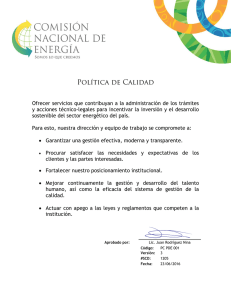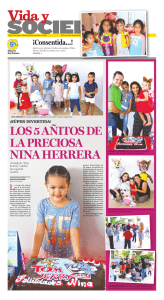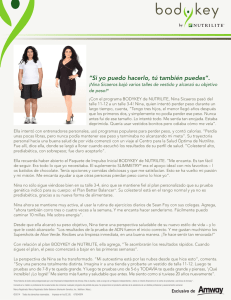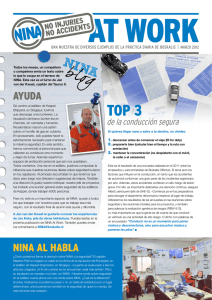an insight of paradise
Anuncio
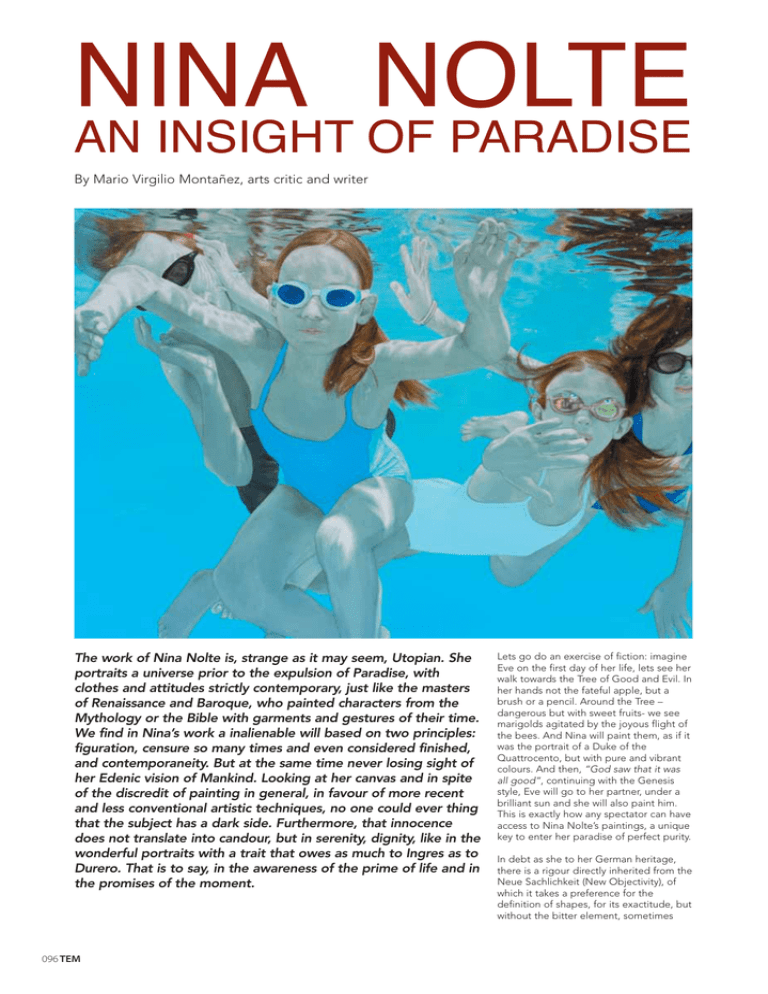
NINA NOLTE AN INSIGHT OF PARADISE By Mario Virgilio Montañez, arts critic and writer The work of Nina Nolte is, strange as it may seem, Utopian. She portraits a universe prior to the expulsion of Paradise, with clothes and attitudes strictly contemporary, just like the masters of Renaissance and Baroque, who painted characters from the Mythology or the Bible with garments and gestures of their time. We find in Nina’s work a inalienable will based on two principles: figuration, censure so many times and even considered finished, and contemporaneity. But at the same time never losing sight of her Edenic vision of Mankind. Looking at her canvas and in spite of the discredit of painting in general, in favour of more recent and less conventional artistic techniques, no one could ever thing that the subject has a dark side. Furthermore, that innocence does not translate into candour, but in serenity, dignity, like in the wonderful portraits with a trait that owes as much to Ingres as to Durero. That is to say, in the awareness of the prime of life and in the promises of the moment. 096 TEM Lets go do an exercise of fiction: imagine Eve on the first day of her life, lets see her walk towards the Tree of Good and Evil. In her hands not the fateful apple, but a brush or a pencil. Around the Tree – dangerous but with sweet fruits- we see marigolds agitated by the joyous flight of the bees. And Nina will paint them, as if it was the portrait of a Duke of the Quattrocento, but with pure and vibrant colours. And then, “God saw that it was all good”, continuing with the Genesis style, Eve will go to her partner, under a brilliant sun and she will also paint him. This is exactly how any spectator can have access to Nina Nolte’s paintings, a unique key to enter her paradise of perfect purity. In debt as she to her German heritage, there is a rigour directly inherited from the Neue Sachlichkeit (New Objectivity), of which it takes a preference for the definition of shapes, for its exactitude, but without the bitter element, sometimes ART EXHIBITION even sour of this movement. We could even say that Nina Nolte submerges the paintings of the New Objectivity in the Californian swimming pools, flooded with the comforting sun reflections of David Hockney. Examples of this concept are the canvases entitled Cherubini, but it can also be applied to her great format portraits. The result is astonishing: a reality that declines the hyperrealists’ small details, but that represents the prime of the bodies, the spotless dignity, the simple elegance, the essentiality of flesh, the celebration of the moment. This to a fixed and still time. In the case of Nina Nolte, this is eternity, it is understood as motionless and timeless – something that quite remarkable in her paintings. She offers us flowers and people, landscapes and plants, animals and models posing proud or relaxed, and always confident. This way, Nina makes of every motif, of every subject a hypnotic piece, enhanced by the neutral coloured backgrounds that create chromatic effects inside the best pop painting. Thus, each one of her canvases becomes a votive painting, an icon sacredly lay, an “…each one of her canvases becomes a votive painting, an icon sacredly lay, an opportunity to discover the beauty that nests, stealthy, in every object, in every person, without renouncing to the psychological depth that we can find in pop artists such as Alex Katz.” eternal instant: when there is a sparkle in the glasses and the bottles stop as if they were acquitted of being emptied. Everything, in this world of vertigo and bustle, is to be grateful for. As if her canvases redeemed us from our mistakes and faults. Because painting is an image stopped in time, and it opens - when it’s a work of quality - a window to eternity, contemporary poet from Malaga, Rafael Inglada, asked us “to serve together with arrows, the birds”. And precisely, this is what Nina does, she offers us the birds, but alive and dazzling, before the shot of the arrow. Like in the portrait of the hen Emma, that over the backdrop of the sunset flaunts a presence that more than poultry will correspond to a dragon. Between misfortune and celebration, Nina opts for feasting the senses, the exaltation of life and the presence of beauty. As if it was in the Garden of Eden. We are before an innocent look focused on the innocence before the snake started to slide quietly on the grass, a grass in which the first footsteps are those of Nina Nolte. Permanent exhibition of Nina Nolte at Puntzman Gallery. 952 787 787 opportunity to discover the beauty that nests, stealthy, in every object, in every person, without renouncing to the psychological depth that we can find in pop artists such as Alex Katz. As Lucrecio said, there are teardrops in things (sunt lacrymae rerum), and that vision is what we can apply, without going off the German tradition, to the expressionism. On the other hand, a high TEM 097 NINA NOLTE UNA MIRADA SOBRE EL EDÉN Por Mario Virgilio Montañez, crítico de arte y escritor La obra de Nina Nolte, aunque no lo parezca, es utópica. Ella nos trae un mundo previo al de la expulsión del Paraíso con vestimentas y actitudes estrictamente contemporáneas, del mismo modo en que los Maestros del Renacimiento y del Barroco hacían figurar con ropajes y ademanes de la época a personajes extraídos de la Mitología o de la Biblia. Hay, entonces, en Nina, una voluntad irrenunciable a dos principios: la figuración, tantas veces denostada y hasta dada por definitivamente muerta, y la contemporaneidad. Pero sin perder de vista, Hagamos un ejercicio de ficción: imaginemos a Eva ese primer día de su vida, veámosla camino del árbol del Bien y del Mal. Y en sus manos no pongamos la manzana fatídica, sino un pincel o un lápiz. Alrededor del árbol peligroso, pero de frutos tan dulces, habrá 098 TEM nunca, esa visión edénica de la Humanidad. Viendo sus pinturas, y pese al descrédito que ha caído sobre la pintura en detrimento de las más recientes y menos convencionales técnicas artísticas, nunca se podrá presumir que la persona retratada tiene un reverso oscuro. Más aún, esa inocencia nunca perdida no se traduce en candor, sino en serenidad, en dignidad, como en los maravillosos retratos con un dibujo que debe tanto a Ingres como a Durero. Es decir, en la conciencia de la plenitud de la vida y en las promesas del instante. caléndulas alborotadas por el vuelo gozoso de abejas. Y Nina las retratará, como si se tratara del semblante de un duque del Quattrocento pero con colores puros y vibrantes. Y después, viendo que efectivamente era bueno, por no desprendernos del todo del estilo del Génesis, se acercará a su compañero, bajo un sol radiante, y también lo pintará. Así es justamente cómo cualquier espectador puede tener acceso a la pintura de Nina Nolte, una llave propia para entrar en su paraíso de pureza perfecta. ART EXHIBITION Sin embargo, deudora como es de una tradición propia, la alemana, hay un rigor que hereda directamente de la Neue Sachlichkeit, conocida entre nosotros como Nueva Objetividad, de la que toma la preferencia por la definición de las formas, por su exactitud, pero sin el componente amargo, y hasta agrio, presente en ese movimiento. Podríamos decir, incluso, que Nina Nolte sumerge las pinturas de la Nueva Objetividad en las piscinas californianas, hendidas de reconfortantes reflejos del sol, de David Hockney. Un ejemplo de esta concepción son los dos lienzos titulados Cherubini, pero también se puede aplicar a sus retratos de grandes dimensiones. El resultado será, y es, sorprendente: una realidad que renuncia a las minucias hiperrealistas pero que alcanza a representar la plenitud de los cuerpos, la dignidad impoluta, la elegancia sencilla, la esencialidad de la carne, la celebración del instante. Ese instante eterno en que brillan las copas y las botellas, detenidas de manera que parecen absueltas de tener que vaciarse. Todo ello resulta, en un mundo de vértigo y ajetreo, muy de agradecer. Como si estos cuadros nos redimieran de nuestros errores y culpas. La pintura, al ser imagen detenida en el tiempo, propicia, cuando se trata de obras de calidad, momentos en que nos es dado asomarnos a la eternidad, a un tiempo fijo y sin fuga. En el caso de Nina Nolte, esa eternidad, entendida como atemporalidad inmóvil, es notoria. Ella nos entrega flores y personas, paisajes y plantas, animales y modelos posando altaneros o reposados. Y siempre confiados. De este modo Nina hace de cada motivo, de cada tema, una pieza hipnótica, realzada por los fondos neutros de color que producen efectos cromáticos dentro de la mejor pintura poeta, malagueño y actual, Rafael Inglada, pedía que sirvamos junto a las flechas, los pájaros. Y justamente esto es lo que hace Nina, ofrecernos los pájaros, pero los pájaros vivos y relumbrantes, antes del disparo de la saeta, como en el retrato de la gallina Emma que sobre el fondo de un anochecer incierto ostenta una “...cada cuadro suyo se convierte en una pintura votiva, en un icono sagradamente laico, una oportunidad para descubrir la belleza que anida, sigilosa, en cada objeto, en cada persona, sin llegar a la renuncia en el ahondamiento psicológico que se puede dar, por mencionar un pintor pop, Alex Katz.” pop. Así, cada cuadro suyo se convierte en una pintura votiva, en un icono sagradamente laico, una oportunidad para descubrir la belleza que anida, sigilosa, en cada objeto, en cada persona, sin llegar a la renuncia en el ahondamiento psicológico que se puede dar, por mencionar un pintor pop, Alex Katz. Decía Lucrecio que había lágrimas en las cosas (sunt lachrymae rerum), y esa óptica es la que puede adjudicarse, sin apartarnos de la tradición germánica, en el expresionismo. A cambio, otro alto prestancia que más que a un ave de corral correspondería a un dragón. Entre la desdicha y la celebración, Nina opta por el festín de los sentidos, por la exaltación de la vida y la presencia de la belleza. Como debiera haber sido en el jardín del Edén. Estamos ante la mirada inocente enfocada sobre la inocencia antes de que la serpiente comenzase su deslizamiento silencioso sobre la hierba. Una hierba en la que las primeras huellas son las Nina Nolte. Exposición permanente de Nina Nolte en Puntzman Gallery. 952 787 787 TEM 099
